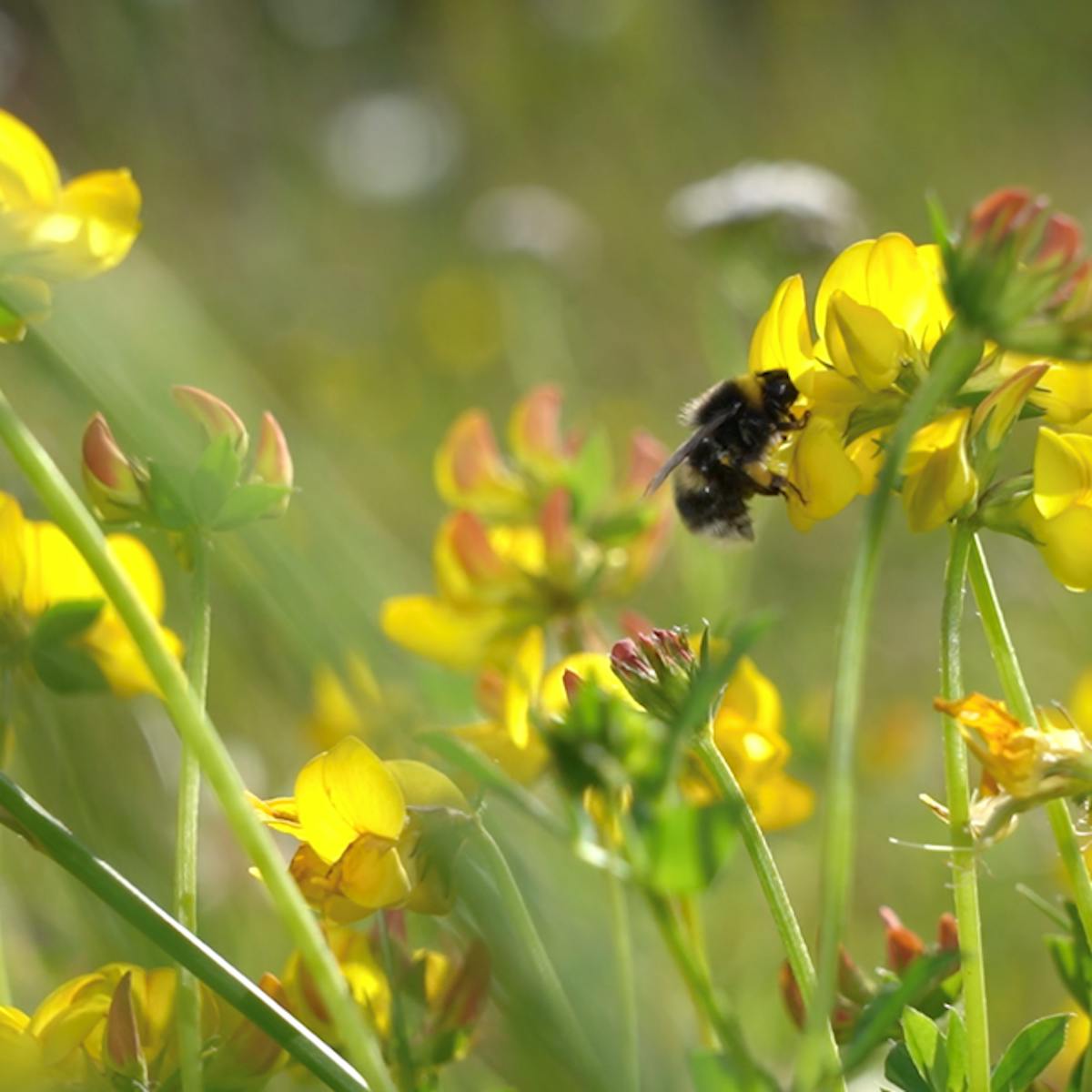Choosing to look down, and up close, at wildflowers has made Amanda Thomson’s walks even more interesting. But botany is not always benign. In this extract from the anthology ‘This Book is a Plant’, Amanda shares a newfound fascination with flowers, and reveals why our relationship with plants can also be complicated.
What the wind can bring
Words and films by Amanda Thomsonaverage reading time 8 minutes
- Book extract

Recently I’ve been paying more attention to wildflowers. I’ve always been a birdwatcher, but flowers have added another dimension to my walks, slowing me, making me look down and around and up close as well as up and away. On steep hill walks, they’re also an excuse to stop.
I’m an amateur and know little of their botany, aside from what’s visibly before me. I only have a common, everyday knowledge of plants. As a child, I made daisy chains, plucked dandelions and blew their clocks to tell the time. I’d hold buttercups under my friends’ chins to see if they liked butter.
Some of my knowledge was more whimsical, other aspects were more practical. I somehow knew that if I was to get stung by nettles, I should reach for one of the dock leaves that always seemed to grow nearby to salve the sting. Yet I don’t know if there’s a reason why these plants grow in such close proximity (or whether they always do), or whether it was just a childhood perception.
In recent years, I’ve come to be able to spot and name common plants like speedwells and sorrels, trefoils, clovers and willowherbs, and a few that are less common, like the wintergreens and, rarer still, twinflowers. I revel in names like self-heal, eye-bright, tormentil, butterwort, devil’s-bit scabious, bitter vetch.
We are learning more and more about the invisible and imperceptible concepts of entanglement and coexistence between plants and between species, above and below the soil. We’ve come to think of these subterranean connections as the wood wide web, but so many connections and intertwinings are right in front of us.
I know now that nettles also make for good soup and tea, and can work as a substitute for spinach. I’ve seen writhing masses of black caterpillars on a bed of nettles – those of the peacock butterfly. I know now that nettles are food for the larvae of red admirals and small tortoiseshell butterflies as well as moths like the burnished brass, and are an important plant for so many seed- and insect-eating birds.
Other plants have other symbioses: in our garden, blue butterflies flit around the bird’s-foot trefoil, and I know it’s also the main food plant of the six-spot burnet moth, a beautiful, shimmery black-green moth with, yes, six scarlet spots on its wings.
Common blues and meadow browns also love the common knapweed that grows alongside the trefoil, and siskins and goldfinches devour the seeds of that same plant at the end of the summer. Around and about throughout are countless flies, bees and micro-moths that I can’t even begin to identify.
The seeds of colonialism
Our knowledge of the benefits and potential dangers of plants is written into our folklore and histories: we know of their uses for medicine, poison and protection against evil, and of their economic importance too.
St John’s wort, used as an antidepressant, was also said to ward off evil, butterwort was used to curdle milk and, traditionally, eye-bright was used for eye infections. Rowans were thought to protect people from harm, plantains stopped bleeding; self-heal used to heal wounds, stop bleeding, cure liver and kidney problems.
So many plants were used to treat the coughs and colds and bronchial complaints that I can’t help think would have accompanied Scotland’s winter cold and damp. Heather was used for rope making and insulation, bent grass for thatching. Nettles used to be used as a cough medicine, a dye, for curdling milk, and, as fibres, woven into twine and fabric.
Our relationship to plants, however, has not always been and is not always benign. I remember hearing the art historian Anna Arabindan-Kesson talk about cotton, focusing on the plant as a way of exploring the interconnections of art, trade, colonial expansion and slavery.
She discussed, among other things, “negro cloth” – the rough cotton used for the clothing of the enslaved, as well as 19th-century depictions of Black bodies that were often central to aesthetic renderings of the cotton trade, and in doing so revealed the racialised discrimination and violence inherent to our relationship with this plant.
Mark Nesbitt’s and Caroline Cornish’s work, ‘Seeds of empire: economic botany collections between nature and culture’, shows how the material objects found in botany collections gathered during the 19th century reveal habits of appropriation and theft as well as scientific discovery.
The very terminology we use about plants seems loaded when we speak of native and non-native, ‘invasive’ and ‘exotic’ species.
Botanic gardens are now often at the forefront of plant research and conservation, but we know their histories are tied to colonial expansion and exploitation, and they are filled with species brought back to the UK from the early ‘exploratory’ expeditions that were in the service of empire. Many of these plants are those that now populate the UK’s gardens.
The very terminology we use about plants seems loaded when we speak of native and non-native, ‘invasive’ and ‘exotic’ species, and in how some are seen as benign, some threatening. It’s hard not to be conscious of language and this broader context when, in conservation and ecology, there’s talk of protecting native species and removing invaders.
The significance of weeds
These days, I volunteer at a tree nursery, where we tend to the downy birches, montane willows and other species that, from impossibly small beginnings, will eventually find their way back into some of the upland wildernesses of the Highlands, where they will be replanted in areas where these species once grew. It is part of a project that seeks to restore such species to their former reach.
One day, one of the other volunteers, an ecologist, mentions that the weeds I’ve been pulling out from around the birch seedlings are thale cress – tiny white flowers that sit atop a five-centimetre-tall, slender stem with the tiniest rosettes of leaves at its base. Thale cress, she tells me, was the first plant to be genetically sequenced, and it’s odd to realise that this tiny and seemingly insignificant plant – which I’ve been plucking and discarding for hours – is actually quite important.
It’s all about context. As Richard Mabey memorably said, “the ornamental in one place becomes the malign invader in another… Just as readily the weed is domesticated into a food plant, or a children’s plaything, or a cultural symbol.”
When I get home I seek out more information and come across the scientist Nicholas Harberd’s book ‘Seed to Seed’, which documents the life of thale cress and the journey to understand its genetic sequence.
I’m not a scientist, and don’t have that kind of brain, so in my reading only tangentially take in the intricacies and implications of the science of DNA that Harberd so eloquently describes, but he talks about the everyday in ways that send my thinking in new directions.
For instance, I’ve never thought about the parts of a leaf before: “The top half of the leaf is more concerned with the harvesting of sunlight during photosynthesis, whereas the bottom half is more for gaseous exchange, for the absorption of oxygen and carbon monoxide from the air.”
I start to look at leaves differently, lift them to see their undersides, and think of each leaf and what it needs to be capable of doing. I watch how things grow and senesce over the year. Even a single summer’s day can hold so much change: I watch cat’s ears and dandelions open up their flowers towards the sun and shift with its movement west, closing again in the evening to protect their seeds.
And yet I know nothing of the nanosecond-to-nanosecond invisible adjustments and changes each plant, animal, living thing makes to adjust to the most micro of environmental changes.
Harberd tells me there’s a gene that’s activated by a fall in temperature, which triggers another that encodes a protein that protects the thale cress’s cells against the effects of cold weather. Its root uses gravity to know the direction to grow in, the cells that constitute it containing starch grains that are heavier and therefore pulled down by gravity towards the earth’s core.
And if a root encounters an obstacle – say, a stone – its tip triggers a hormone that sends a message back up the chain which will slow its growth, and allow it to feel its way around the obstacle. “So a growing root is a sensitive thing, picks its way through the texture of the soil, finds the best path.”
‘This Book is a Plant’ is out now.
About the author
Amanda Thomson
Amanda Thomson is a visual artist and writer and a lecturer at the Glasgow School of Art. Her creative nonfiction has appeared on BBC Radio 4, and in a number of anthologies. She also writes for the Guardian’s ‘Country Diary’. She earned her doctorate in interdisciplinary arts practice, focusing on the landscapes and forests of the north of Scotland, in 2013, and her work is frequently about the Scottish Highlands. She lives and works in Strathspey, in the Highlands, and in Glasgow. Her first book, ‘A Scots Dictionary of Nature’, is published by Saraband Books. Her second book, ‘Be/longing: natural histories of place, identity and home’, will be published by Canongate in August 2022.
